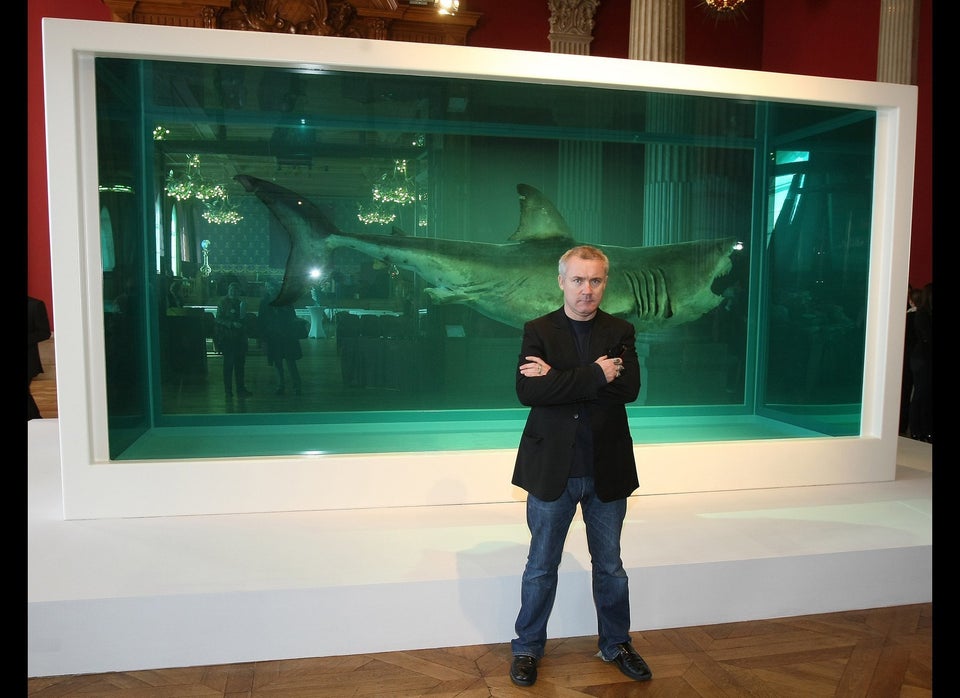"Art's popular. That's my generation. It wasn't before." So declared Damien Hirst in 2000. Anyone who has any doubt of the validity of Hirst's claim should go directly to his current retrospective exhibition at London's Tate Modern. When I first went, on a Bank Holiday, the long lines and excited conversations made me feel that I was not at an art show, but a rock concert. Several Tate employees told me the only previous exhibitions that had generated as much buzz on-site were Picasso/Matisse and Warhol. It is very difficult to imagine any other living artist producing anything approaching the commotion of Hirst's show.
The Hirst retrospective is nothing like a traditional art exhibition, not only because of the audience and its behaviors, but because of the works themselves. It is much more reminiscent of a carnival or county fair. Some of the exhibits are colorful and decorative; others are mildly distasteful, like old-fashioned freak shows; yet others are apparently educational. The normally hushed atmosphere of museums is replaced by the noisy, boisterous crowd of the fairground. Children run from room to room, chasing live butterflies and climbing on the sides of a giant ashtray containing dead cigarette butts, and adults tap on the sides of large vitrines containing live and dying flies. A supervisor told me that it's simply not possible to stop spectators from touching these, so they don't bother to try.
Michael Skapinker accurately observed in The Financial Times ("Damien Hirst's Four Faces of Commerce,") that Hirst is unique among artists of the present, and also perhaps of the past, as a producer of revenue, and suggested that he is worthy of study by MBA students. Skapinker observed that Hirst excels as a showman, a popular entertainer in the tradition of P.T. Barnum; as an adman, who creates enduring images (e.g. a shark in formaldehyde); as a luxury brand manager, who captures the fancy of the wealthy leisured class; and as a trader, whose market timing produced revenues of £111 million at a two-day Sotheby's auction that coincided with the failure of Lehman Brothers.
Hirst's enormous financial success, and the conspicuous delight he takes in it, have produced anguish, envy and outright hostility among many in England's staid and priggish art world, who cling to the ancient ideal that artists should be secular priests, who take vows of poverty and regard money as a source of corruption. His current exhibition has consequently provided an occasion for renewed debate over whether Hirst is a great artist or a con artist. Thus Michael Craig-Martin hails his former student as the initiator of a "new and exciting atmosphere of creative endeavor and opportunity," while at the opposite pole Julian Spalding argues that Hirst's products are not only "worthless as works of art," but furthermore "worthless financially" [sic].
Whether you like his work or not, it is now perverse to deny that Hirst is an important artist. True importance in art is determined not by the judgments of critics or scholars, but by influence within advanced art. And to ignore Hirst's influence on contemporary art is simply to be in denial. Art scholars have clearly recognized Hirst's importance to contemporary art by giving him a leading position in their narratives. Thus my tabulation of the illustrations in 21 textbooks of art history published since 2000 revealed that Hirst stood fourth, behind only the older artists Cindy Sherman, Gerhard Richter and Jeff Koons, in total illustrations of works executed since 1975. Hirst has been the leader of the most vital art movement to emerge anywhere in recent decades, characterized by highly conceptual works that are transgressive, personal, and often shocking: Tracey Emin, Jake and Dinos Chapman, Chris Ofili and Sarah Lucas are other prominent members, all subordinate to Hirst. And the benefits of this group go beyond the wealth and fame of the individuals. Just as the original Yankee Stadium was the "House That Ruth Built", so Tate Modern, with the largest attendance of any museum of modern art in the world, can fairly be called the "House That Hirst Built."
With the current retrospective, timed to coincide with the Olympics and the world-wide publicity they will bring to London, Hirst has been elevated and anointed by the English establishment no less certainly than if he had been given a knighthood. And a visit to the exhibition's gift shop quickly dispels any doubt that the venerable Tate is embracing Hirst's love of the commercial as well as his art. In addition to the usual t-shirts, postcards and catalogues, there are more unusual items, including bone china sets and custom-printed skateboards, limited-edition prints, and most intriguingly, Transcendent Head -- a plastic skull covered with gloss paint, signed and numbered in an edition of 50, priced at £36,800 each, including VAT.
After Marcel Duchamp's Fountain was rejected by the American Society of Independent Artists in 1917, Louise Norton wrote that "There are those who anxiously ask, 'Is he serious or is he joking?' Perhaps he is both! Is it not possible?" The question continues to haunt the art world today. Following Duchamp, Warhol, Beuys, Klein, Manzoni and Koons, Damien Hirst poses the problem of the artistic trickster in yet another guise. Is he an artist or is he an entrepreneur? Can't he be both? Is it not possible?
